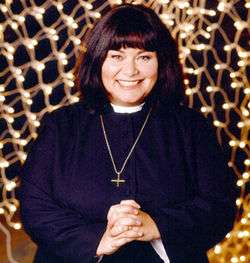Geraldine Granger
| Reverend Geraldine Granger | |||||||
|---|---|---|---|---|---|---|---|
 | |||||||
| The Vicar of Dibley character | |||||||
| Portrayed by | Dawn French | ||||||
| First appearance | "The Arrival" | ||||||
| Last appearance |
"The Vicar in White" (main) "The Bishop of Dibley" (sketches) | ||||||
| Profile | |||||||
| Occupation |
Vicar (1994–2015) Unemployed (2015–?) | ||||||
| |||||||
Boadicea Geraldine Kennedy (née Granger) is a fictional female vicar, the central character to the successful British BBC sitcom The Vicar of Dibley. She is portrayed by Dawn French, described by the British Comedy Guide as "the jolly, down-to-earth female vicar of Dibley, a small country village inhabited by oddballs. After overcoming the town's initial shock at her gender Geraldine helps to improve the village."[1] Much of the source of comedy comes from the way French plays the female vicar with her extroverted and fun-loving nature,[2] frequent colourful language, and behaviour as a vicar which would usually be frowned on by the church.
The character made a debut in 1994,[3] and on 15 March 2013, French reprised her role as Granger as part of her French and Saunders marathon on BBC Radio 2.
Character
Granger arrived at the parish church to a shocked congregation, leading her to remark: "You were expecting a bloke - beard, bible, bad breath. And instead, you got a babe with a bob cut and a magnificent bosom."[4] She is a bonne vivante and a liberal woman who enjoys nothing more than a good laugh, much to the consternation of her love interest David Horton. Despite her fun-loving and sometimes outrageous behaviour, she is deeply caring and does her best to help those in her parish in any way she can. She is well aware of her obesity but seems to take a relatively laid-back attitude toward it. A self-confessed chocoholic,[3] her favourite being Smarties and Curly Wurlys, she often will go on a diet only to break it within minutes by eating one of the innumerable chocolate bars that she has hidden throughout her house (even in hollowed-out Bibles). On one occasion, she gives up chocolate for Lent and nearly goes mad but does succeed. She has an enormous crush on actor Sean Bean.
Despite her kind-hearted nature, Geraldine is not above occasional arrogance. In the second-season episode "Celebrity Vicar", after a spot on local radio led to several high-profile media appearances, Geraldine allowed fame to go to her head, and became overconfident and self-absorbed, caring more about her public image and TV career than she did about her parishioners or her duties as a priest. She was later humbled after the tabloids printed several offensive articles about the members of the village council, and she struggled to regain their trust.
Her unusual first name Boadicea is revealed later in the series, much to David Horton's ongoing amusement, although in the final episode her full name is given as Geraldine Julie Andrews Dick van Dyke Supercalifragilisticexpialidocius Chim-Chiminey Chim-Chiminey Chim-Chim-Cheree Granger, the latter due to her mother's favourite book being Mary Poppins and the fact that the film was released the year of Geraldine's birth.
Her best friend is Alice Tinker (Emma Chambers);[5] at the end of each episode she tells a joke to Alice, but Alice rarely understands the humour. Geraldine was once going to marry David Horton but decided not to after all. In 2006, she receives a proposal from accountant Harry Jasper Kennedy and accepts by running around the village, screaming. In the final episode she marries him in a bizarre wedding with touches of Doctor Who, including the two bridesmaids being dressed as Daleks and with parts of the church decorated with vegetables. She ends up getting married in her pyjamas because her wedding dress has been accidentally covered with mud by Owen Newitt.
References
- ↑ "The Vicar Of Dibley". British Comedy Guide. Retrieved 29 March 2013.
- ↑ Berman, Garry (2011). Best of the Britcoms: From Fawlty Towers to The Office. Taylor Trade Publications. p. 113. ISBN 978-1-58979-566-2. Retrieved 29 March 2013.
- 1 2 The New Yorker. February 2010. p. 40. Retrieved 29 March 2013.
- ↑ Florence, Anna Carter (2007). Preaching As Testimony. Presbyterian Publishing Corp. p. 113. ISBN 978-0-664-22390-8. Retrieved 29 March 2013.
- ↑ Paietta, Ann C. (2005). Saints, Clergy, and Other Religious Figures on Film and Television: 1895 - 2003. McFarland & Company, Pub. p. 178. ISBN 978-0-7864-2186-2. Retrieved 29 March 2013.